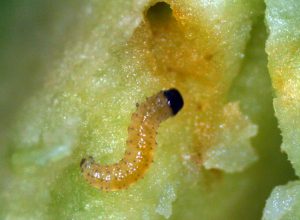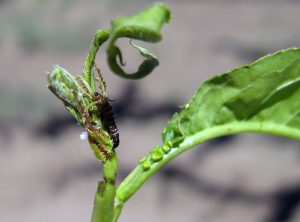In this Issue:
- Apple, Pear: codling moth dates available
- Peach/Nectarine, Apricot, Plum: peach twig borer spray dates for southern Utah
APPLE, PEAR
Codling Moth
egg hatch prediction dates provided for several locations in the link below

Codling moth treatment timing is coming up in late May for many areas of northern Utah. We will provide information about the remaining locations once we have captured moths in our traps.
View a pdf of the spray timing table. Be sure to read the instructions at the top of the page, for how to read the table.
Not all Utah locations are provided on the table. Select your closest city, or, go to the Utah TRAPs website, select your city, and select “Codling Moth-Fixed Biofix” from the drop-down menu.
On the table in the link above, there are two options provided for your first application. “Option A” is standard procedure, where you apply the insecticide you choose at the date provided.
“Option B” uses horticultural oil (at 1% concentration in water) as the first application on the date provided, followed by an insecticide application about 2 weeks later. This option saves one general insecticide spray because the oil kills (smothers) all codling moth eggs laid up to that point, and ideally before any of them have hatched.
For either option, it is recommended to repeat the application to protect fruit at least through the “period of greatest egg hatch” (dates shown on the table).
Treatment
Options for commercial growers.
Options for residential growers are shown in the table below. (Click here and here for more info on bagging fruit, which is done when you thin the fruit after bloom, or when they are about 0.5″ diameter.)
| Product Name | Efficacy | Residual Length (days) | Comments |
|---|---|---|---|
| CONVENTIONAL | |||
| Spectracide Triazicide (gamma-cyhalothrin) | Good to Excellent | 14-17 | wait 21 days to harvest |
| Monterey Bug Buster 11 (esfenvalerate) | Good to Excellent | 14-17 | wait 21 days to harvest |
| Bonide Fruit Tree & Plant Guard (lambda-cyhalothrin) | Good to Excellent | 14-17 | wait 21 days to harvest |
| Bonide Malathion; Hi Yield Malathion | Good | 5-7 | max 2 applications; some products are pears only |
| GardenTech Sevin (zeta-cypermethrin) | Good to Excellent | 14-17 | wait 14 days to harvest |
| ORGANIC | |||
| AzaSol, EcoGarden (azadirachtin) | Good | 7-10 | purchase online |
| Cyd-X (codling moth virus) | Good (if populations are low) | 7 | works best when used at beginning of generation; expensive and purchase online |
| oil such as All Seasons Oil, EcoSmart, Neem oil | Good on eggs only | 3 | recommended for first application of the generation only |
| Ortho Fruit Spray; Fertilome Fruit Tree Spray; Safer End All; Bonide Orchard Spray (all contain pyrethrin) | Good | 3-5 | |
| Monterey / Fertilome Spinosad; Captain Jack's Deadbug Brew; Natural Guard (all contain spinosad) | Good | 10 | max 6 applications per season; if applying to peach or cherry, can re-apply after 7 days |
For strategies on how often to spray for codling moth, it will depend on whether you are using organic or non-organic options, AND how heavily your apples or pears have been infested with codling moth in the past.
Conventional production options
- High fruit damage in past years:
- Apply the first application for either Option A (insecticide) or Option B (oil).
- For Option A, repeat the insecticide spray 14 days later, for a total of 2 applications in the first generation.
- For Option B, apply the insecticide spray at the listed date once.
- When the “start date” for the 2nd generation is provided, spray every 10-18 days until Sept. 15.
- Pick a different product to use for each generation.
- Low fruit damage in past years:
- Apply the first application for either Option A (insecticide) or Option B (oil).
- For Option A, do not spray again.
- For Option B, apply insecticide at the listed date.
- Wait until the “start date” for the 2nd generation is provided, and spray on that date, and repeat 14 days later, for a total of 2 sprays.
- Do the same for the 3rd generation.
- Pick a different product to use for each generation.
Organic production options (other than bagging)
- High fruit damage in past years:
- Apply the first application for either Option A (insecticide) or Option B (oil).
- For Option A, repeat twice, spaced 7-10 apart, for a total of 3 applications in the first generation.
- For Option B, apply insecticide at the listed date and re-apply 7-10 days later.
- When the “start date” for the 2nd generation is provided, spray every 7-10 days until Sept. 15.
- Pick a different product to use for each generation.
- Low fruit damage in past years:
- Apply the first application for either Option A (insecticide) or Option B (oil).
- When the “start date” for the 2nd generation is provided, spray every 10-14 days until Sept. 15.
- Pick a different product to use for each generation.
PEACH, NECTARINE, APRICOT
Peach Twig Borer

peach, nectarine, apricot – spray dates for some areas of southern Utah
Peach twig borer is active in the warmest southern Utah locations. This pest prefers to feed inside succulent peach shoots, but later in the summer, it feeds inside the fruits themselves. It is best to knock the population down early rather than waiting until later.
Application timing dates:
- Hurricane: May 16
- Capitol Reef: May 30
- Zions Canyon area: May 15
- Kanab: May 29
- Leeds: May 17
- St. George: May 15
Treatment
Options for commercial growers.
For residential trees, use same product as codling moth (see above)
